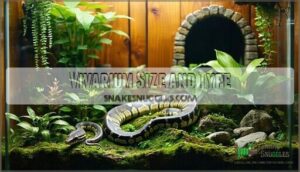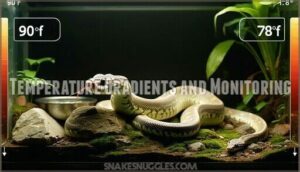This site is supported by our readers. We may earn a commission, at no cost to you, if you purchase through links.

You’ll want a 40-gallon vivarium minimum with proper substrate, hiding spots, and temperature gradients between 78-88°F.
Maintain 50-60% humidity using water bowls and humid hides.
Feed juveniles weekly, adults every 7-14 days with appropriately sized frozen-thawed prey.
These gentle giants rarely bite when handled properly, making them excellent beginner snakes.
Regular weighing prevents obesity while monitoring helps catch health issues early.
The devil’s in the details though – substrate choice alone can make or break your snake’s comfort and health.
Table Of Contents
- Key Takeaways
- Royal Python Overview
- Habitat Requirements
- Heating and Lighting Needs
- Humidity and Hydration
- Diet and Feeding Guidelines
- Frequently Asked Questions (FAQs)
- How to care for royal python?
- What is the best bedding for a royal python?
- Is 40% humidity okay for a ball python?
- What temperature should a royal python enclosure be at night?
- What morphs are available for royal pythons?
- How often should royal pythons visit veterinarians?
- What health problems affect royal pythons commonly?
- How long do royal pythons live?
- Can royal pythons be housed together safely?
- Conclusion
Key Takeaways
- You’ll need a 40-gallon minimum enclosure with wooden construction for better heat retention, proper substrate like aspen or bark chips, and multiple hiding spots to create a secure environment for your royal python.
- Maintain temperature gradients between 78-88°F using basking heat lamps and heat mats with thermostats, while keeping humidity at 50-60% (boosting to 70-75% during shedding) with water bowls and humid hides.
- Feed juveniles weekly and adults every 7-14 days with appropriately sized frozen-thawed prey that’s 10-15% of your snake’s body weight, avoiding handling for 48 hours after meals to prevent regurgitation.
- Monitor your snake’s weight regularly and handle gently to build trust with these docile creatures who rarely bite when proper techniques are used, making them excellent beginner snakes with 20-30 year lifespans.
Royal Python Overview
You’re about to discover why royal pythons have become one of the most popular pet snakes worldwide.
These gentle, medium-sized constrictors from sub-Saharan Africa offer the perfect combination of manageable size, calm temperament, and striking beauty that makes them ideal for both beginners and experienced keepers, with gentle and striking beauty being key attributes.
Royal pythons combine manageable size with gentle temperament and stunning natural beauty—the perfect beginner snake.
Native Habitat and Distribution
Throughout sub-Saharan Africa’s semiarid grasslands, you’ll find royal pythons thriving in their ancestral homeland. These serpents call western and central Africa home, adapting beautifully to African scrubland environments.
Their wild distribution spans three key regions:
- Savannah homes – Open grasslands with scattered trees
- African scrubland – Dense brush and thorny vegetation
- Desert life margins – Arid zones bordering true deserts
Understanding these African roots helps you recreate proper captive conditions for your snake’s wellbeing. Royal pythons have unique python habitat needs that must be considered for ideal care.
Physical Characteristics and Size
Royal pythons showcase distinctive physical traits that make them instantly recognizable.
Females typically reach 4-6 feet in snake length, while males stay smaller at 3-4 feet.
Their royal color patterns feature rich browns and golds with intricate scale patterns creating stunning geometric designs.
Ball pythons display robust body proportions with thick, muscular builds.
Understanding python size differences helps you plan appropriate housing for your royal python care needs, and recognizing the distinctive physical traits is essential for this understanding.
Temperament and Handling
Beyond their impressive size, ball pythons possess remarkably calm temperaments that make them excellent pets for beginners.
Ball pythons make perfect beginner snakes with their gentle nature and stunning beauty.
Snake behavior patterns show they rarely bite when handled gently from hatchling stage. Their famous defensive response—coiling into a tight ball—gives them their common name.
Proper handling tips include supporting their body weight and moving slowly. Gentle care builds trust, making snake handling techniques more effective.
Temperament tests through consistent interaction reveal their docile nature. Proper care and handling are key to a positive experience with ball pythons, and understanding their behavior is essential for building a strong bond, based on gentle care and proper handling.
Shedding and Skin Renewal
Like clockwork, your python will shed its skin every 4-6 weeks as it grows.
You’ll notice their eyes turn milky blue during the shedding process – that’s your cue to boost humidity control to 60-70%.
Proper scale care during this renewal cycle prevents stuck shed, which can cause serious python molting issues.
Monitor skin health closely and provide a humid hide for successful snake skin shedding.
Habitat Requirements
Creating the right home environment for your royal python is essential for their health and wellbeing.
You’ll need to focus on four key areas: choosing an appropriately sized vivarium, selecting proper substrates, providing adequate hiding spots, and ensuring proper insulation for temperature control.
Vivarium Size and Type
Choosing the right vivarium setup forms the foundation of successful python care. Your royal python needs adequate space to thrive and feel secure.
Here are five essential considerations for vivarium selection:
- Tank Size: Adult pythons require minimum 120x60x60cm enclosures, though larger vivariums improve enrichment opportunities
- Vivarium Materials: PVC and wooden enclosures retain heat better than glass tanks, reducing heating costs
- Enclosure Types: Front-opening doors provide safer access than top-opening designs for routine python enclosure maintenance
- Habitat Design: Secure locking mechanisms prevent escapes while ventilation prevents mold growth
- Reptile Housing: Modular systems like Exo Terra caves allow expansion as your snake grows
Properly designed Royal Python Enclosures are essential for creating a healthy environment.
Remember, your python will spend its entire life in this space—investing in proper reptile tank maintenance and quality vivarium setup pays dividends in your pet’s health and happiness.
Substrate Options and Maintenance
After selecting your vivarium, substrate choices will create the foundation for your python’s comfort.
You’ll want materials that maintain proper moisture levels while preventing bacterial growth.
The quality of aspen substrate products can substantially impact the overall health of your royal python.
| Substrate Types | Humidity Control | Cleaning Methods |
|---|---|---|
| Aspen substrate | Low moisture retention | Spot clean weekly |
| Bark hide chips | Moderate humidity | Replace monthly |
| Beech chips | Good moisture balance | Deep clean biweekly |
Vivarium linings should allow natural burrowing behaviors while supporting easy reptile tank maintenance routines.
Hides and Burrowing Opportunities
Privacy matters for your royal python’s peace of mind.
Reptile hides like Exo Terra caves provide essential security, while burrowing boxes filled with aspen substrate satisfy natural digging instincts.
Create multiple hide caves throughout your wooden vivarium—one warm, one cool.
Rock piles and tunnel systems using bark hide offer exploration opportunities.
These snake dens reduce stress substantially, and by including them, you can ensure your royal python has a stimulating environment with essential elements for its well-being.
Insulation and Warmth Retention
Proper vivarium insulation acts like your home’s winter coat – it keeps warmth where it belongs.
Wooden vivariums excel at heat retention compared to glass alternatives, while thermal mass from substrate and décor helps maintain stable temperatures.
Your python’s thermoregulation depends on consistent warmth distribution throughout their environment.
- Wooden vivarium construction provides superior insulation compared to glass tanks, reducing heating costs and maintaining stable temperatures
- Strategic heat mat placement under one-third of the enclosure creates thermal gradients while substrate acts as thermal mass
- Draft prevention around doors and vents guarantees heat sources work efficiently without temperature fluctuations
Heating and Lighting Needs
Creating the right thermal environment is essential for your royal python’s health and comfort. You’ll need to establish proper temperature gradients and lighting cycles that mimic their natural African habitat.
Basking Heat Lamp and Temperature
The basking heat lamp serves as your royal python’s primary Heat Sources, creating essential thermal gradients for proper thermoregulation.
Position ceramic heat emitters or halogen bulbs 10-12 inches above the basking surface to achieve perfect snake temperature control.
| Heat Sources | Temperature Range | Placement | Safety Features |
|---|---|---|---|
| Ceramic Heat Emitters | 88-92°F (31-33°C) | 10-12" above surface | Screen guard required |
| Halogen Bulbs | 88-92°F (31-33°C) | One end of enclosure | Thermostat control |
| Reptile Incandescent | 88-92°F (31-33°C) | Above primary hide | Burn protection |
| Dimmable Options | Variable control | Strategic positioning | Temperature monitoring |
Use thermostats for precise temperature regulation—they’re your safety net against overheating disasters that stress snakes.
When selecting a basking heat lamp, consider the heat lamp options available to guarantee the best fit for your royal python’s enclosure.
Heat Mats and Supplemental Heat
Heat mats provide gentle supplemental heating from below, mimicking natural warmth your royal python would experience from sun-heated rocks.
You’ll need a thermostat to prevent overheating and maintain proper temperature control. These heat sources work alongside your basking heat lamp to create ideal heat distribution throughout the vivarium.
Always place ceramic heaters or heat mats outside the enclosure with mat safety guards to prevent burns and maintain consistent reptile heating. Proper temperature control systems are essential for creating a healthy environment for your royal python.
Lighting Options and Photoperiod
Unlike mammals, lighting isn’t critical for royal pythons since they’re naturally crepuscular creatures. However, LED lighting with 6500K color temperature can enhance your python habitat setup and showcase reptile decor beautifully.
UVB options aren’t essential but may support overall health. Establish consistent photoperiod cycles—12 hours on, 12 hours off—to maintain natural rhythms.
Keep lighting intensity moderate to avoid stressing your snake. Many reptile lighting options exist, but remember: your python care guide should prioritize heating over illumination for superior snake care tips.
Temperature Gradients and Monitoring
Your snake needs a thermal gradient with the hot side at 88-91°F and cool side at 78-80°F.
Use digital reptile thermometers with probes at both ends to monitor accurately. A quality snake thermostat controls heat sources automatically, preventing dangerous temperature spikes.
Check readings daily – your python’s health depends on consistent thermal monitoring and proper gradient management.
Humidity and Hydration
You’ll need to maintain proper humidity levels between 50-60% to keep your royal python healthy and support successful shedding cycles.
A reliable hygrometer and consistent water bowl maintenance will help you create the right environment for your snake’s respiratory health and hydration needs.
Ideal Humidity Levels and Monitoring
Consistently maintaining proper humidity control guarantees your royal python’s health and successful shedding cycles.
You’ll need moisture levels between 50-60% daily, rising to 70-75% during shedding periods. Digital hygrometers provide accurate readings—place one mid-enclosure and another near the humid microclimate.
Multiple sensors reveal important gradients since python humidity levels often vary 20-30% within the same vivarium.
Snake humidity monitoring prevents dehydration and respiratory issues while supporting healthy skin renewal.
Maintaining ideal humidity requires understanding humidity control methods to create a stable environment and ensure healthy skin renewal with accurate readings and proper humidity control.
Humid Hide and Water Bowl Maintenance
You’ll want to keep your snake’s humid hide properly maintained to support healthy shedding. The hide box should maintain consistent moisture levels without becoming waterlogged, which could lead to respiratory issues.
Here’s your maintenance routine:
- Replace substrate weekly – Swap out damp moss or paper towels in the humid hide to prevent bacterial growth
- Clean the water bowl every few days – Fresh water prevents algae buildup and maintains water quality
- Monitor python humidity levels – Check that your humid hide stays between 80-90% humidity using a digital hygrometer
Royal python care sheet basics emphasize that snake humidity requirements differ from overall enclosure levels. Your python water bowls need regular attention since stagnant water can harbor harmful bacteria. Bowl cleaning becomes second nature once you establish this simple routine.
Hydration and Drinking Water Quality
Clean water forms the foundation of proper royal python hydration. You’ll need dechlorinated or filtered water to prevent chemical buildup that could harm your snake’s delicate system.
Change the water weekly or whenever it becomes soiled, as bacteria can multiply quickly in warm, humid environments.
| Water Quality Factor | Recommended Standard | Monitoring Frequency |
|---|---|---|
| pH Level | 6.5-7.5 neutral range | Monthly testing |
| Chlorine Content | Zero (dechlorinated) | Each water change |
| Temperature | Room temperature | Weekly checks |
| Cleanliness | Crystal clear, odorless | Daily visual inspection |
| Bowl Sanitization | Deep clean with reptile-safe soap | Weekly maintenance |
Your reptile hygrometer should read 50-60% humidity levels for ideal snake care basics. Python water bowls require strategic placement away from heat sources to prevent rapid evaporation.
These hydration tips guarantee your royal python care sheet standards remain consistently high throughout your pet’s life.
Diet and Feeding Guidelines
Feeding your royal python properly guarantees healthy growth and prevents common health issues that many new owners encounter.
You’ll need to establish a consistent feeding schedule and understand the specific dietary requirements that keep these snakes thriving in captivity, which is crucial for their overall well-being.
Prey Items and Feeding Frequencies
Selecting the right prey items guarantees your python thrives throughout its life.
Prey should match 10-15% of your snake’s body weight.
- Mice and rats – Primary staples for most feeding schedules
- African soft-furred rats – Perfect for picky eaters but avoid dependency
- Young rabbits or guinea pigs – Excellent for larger adult pythons
- Frozen-thawed prey – Safer than live offerings, reduces stress and injury
- Feeding frequency varies – Hatchlings weekly, adults every 2-4 weeks
Food variety prevents nutritional gaps while proper meal size supports healthy growth in your royal python care routine.
Understanding feeding royal pythons is vital for a successful care plan.
Feeding Techniques and Handling
When handling royal pythons during feeding time, you’ll want to use feeding tongs to maintain safe distance and prevent accidental bites.
Never handle your snake for 48 hours after meals to avoid regurgitation.
Pre-killed frozen prey is safer than live feeding, reducing injury risk.
Establish consistent feeding schedules and locations to minimize stress and create predictable python care basics routines, following safe distance guidelines to ensure the well-being of both you and your pet.
Supplemental Nutrition and Vitamins
Proper supplementation supports your royal python’s long-term health when whole prey alone doesn’t meet all mineral needs.
Most pythons thrive on gut-loaded rodents without additional dietary additives, but specific situations may require feeding enrichment through targeted nutrition balance approaches.
Consider these supplementation scenarios for ideal python care basics:
- Calcium powder dusting – Light coating on prey prevents metabolic bone disease
- Monthly multivitamin use – Fills trace nutrient gaps in captive snake diet
- Breeding female support – Increased calcium and D3 during egg production
- Juvenile growth phases – Higher calcium-to-phosphorus ratios for developing snakes
- Gut-loading feeder rodents – Enhanced nutritional value through quality prey diets
Remember that over-supplementation poses risks.
Fat-soluble vitamins can accumulate and cause toxicity, while proper royal python diet typically provides adequate nutrition through well-fed prey animals alone.
Feeding Challenges and Troubleshooting
Sometimes your ball python just won’t cooperate. Feeding issues are normal, especially during shedding, seasonal changes, or stress. Don’t panic—they can survive weeks without eating.
Understanding proper prey size selection is vital to avoid feeding problems and guarantee the snake’s overall health.
| Problem | Solution |
|---|---|
| Snake refuses prey | Try different prey sizes or pre-killed options |
| Wrong feeding frequency | Adjust to every 1-2 weeks for adults |
| Stress-related refusal | Check temperature, humidity, and hiding spots |
Most royal python diet problems stem from environmental factors rather than the snake being picky. Keep detailed feeding records to identify patterns in your python’s behavior.
Frequently Asked Questions (FAQs)
How to care for royal python?
A stitch in time saves nine" – proper care prevents health issues.
You’ll need a 120cm+ wooden vivarium with basking spot at 33°C, cool end at 24°C.
Provide hiding spots, maintain 50-60% humidity, and feed appropriate-sized prey monthly.
What is the best bedding for a royal python?
Use bark chips, aspen shavings, or cypress mulch for your royal python’s bedding.
These substrates maintain proper humidity levels while allowing natural burrowing behaviors.
Avoid cedar or pine, which can cause respiratory issues.
Is 40% humidity okay for a ball python?
No, 40% humidity is too low for a ball python.
You’ll want to maintain 50-60% humidity levels to prevent shedding problems and respiratory issues.
Higher humidity during shedding cycles helps guarantee complete, healthy skin removal.
What temperature should a royal python enclosure be at night?
Like a reptile’s internal thermostat winding down, you’ll want nighttime temperatures dropping to 24°C (75°F).
This natural cooling cycle mimics their African habitat, helping your royal python’s metabolism regulate properly and promoting healthy sleep patterns.
What morphs are available for royal pythons?
Royal pythons have over 7,500 different morphs available, including Albino, Mojave, Clown, Pied, Spider, and Fader varieties. You’ll find endless combinations of colors and patterns.
How often should royal pythons visit veterinarians?
Schedule annual wellness checkups for your royal python. Healthy adults need yearly veterinary visits, while juveniles, seniors, or sick snakes require more frequent monitoring to catch health issues early.
What health problems affect royal pythons commonly?
Like a silent saboteur, health issues can creep up on your python.
Respiratory infections, mites, scale rot, and shedding problems are the main culprits you’ll face—but proper care prevents most troubles.
How long do royal pythons live?
You’ll typically see your royal python live 20-30 years in captivity with proper care, though some exceptional individuals reach their 40s when everything goes right.
Can royal pythons be housed together safely?
You shouldn’t house royal pythons together. They’re naturally solitary animals and cohabitation increases stress, territorial conflicts, feeding competition, and disease transmission risks. Individual housing guarantees their wellbeing.
Conclusion
Sure, you might think royal pythons are high-maintenance pets, but this royal python care sheet overview proves otherwise.
With proper setup and consistent routines, you’ll find these snakes surprisingly manageable. You’ve learned the essentials: appropriate housing, temperature control, humidity management, and feeding schedules.
Remember to monitor your snake’s weight and behavior regularly. Start with quality equipment and don’t rush the process.
Your royal python will reward your careful attention with years of gentle companionship and fascinating behavior.
- https://secure.royalcaribbean.com/cas/savingsCertificates.do?_ga=2.43930917.101099738.1575641657-1116758174.1575641657
- https://www.royalcaribbean.com/cas/legal/
- https://journals.biologists.com/jeb/article/218/14/2279/14389/Snake-constriction-rapidly-induces-circulatory
- https://www.researchgate.net/publication/232678980_Sex_Differences_in_Body_Size_and_Ectoparasite_Load_in_the_Ball_Python_Python_regius
- https://www.reptifiles.com/responsible-reptile-breeding/
















